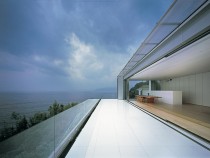
© Shinkenchiku-sha
The relationship between indoor and outdoor space forms part of Japan’s cultural understanding of itself and can be seen in the modern architectural design of that country. It is worth investigating one particular aspect, namely the phenomenon of transparency. In the West, transparent architecture developed parallel to the philosophical opening that occurred after the French Revolution, and it can be seen to symbolize the advance into a new age. In Japan, the concept of transparency develops against a wholly different background. Important for the traditional Japanese house is its link with the surroundings. Bruno Taut wrote that houses of this kind are characterized not by a closed outer skin but by a permeable membrane that allows a maximum interaction with nature, while nevertheless offering protection against the vagaries of the weather.












